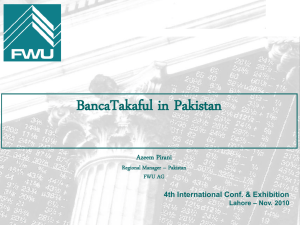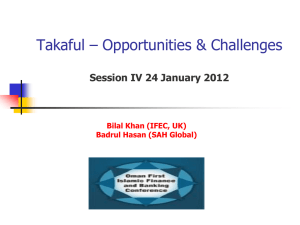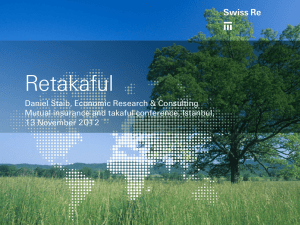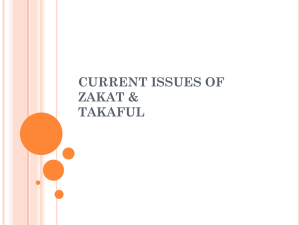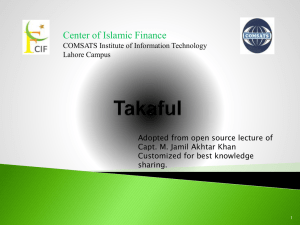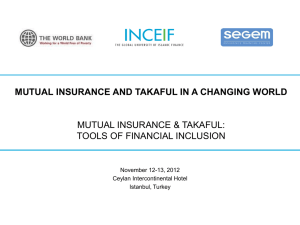systemic risk
advertisement
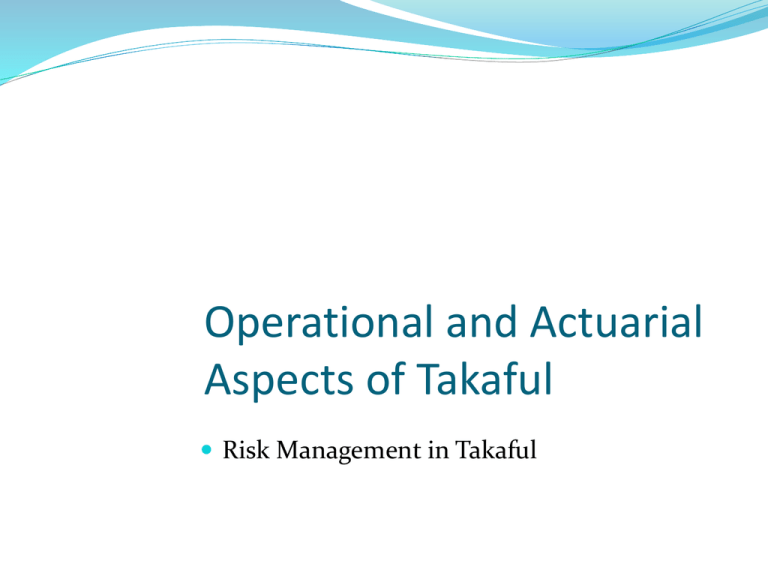
Operational and Actuarial Aspects of Takaful Risk Management in Takaful Sub Topics Introduction Definition of Risk Management Enterprise Risk Management Risk Management in Takaful Overview Introduction ‘The overall process that a financial institution follows to define a business strategy to identify the risk to which it is exposed to, to quantify those risks and to understand and control the nature of risk’ Coming and Hirtle 2001 Introduction “ The essence of risk management lies in maximizing the areas where we have some control over the outcome while minimizing the areas where we have absolutely no control over the outcome…” Peter L. Bernstein The Remarkable Story of Risk Introduction What is Risk ‘Uncertainty of loss from an exposure’ Loss-real loss or not making a gain, usually negative in nature Real or Perceived Risk has no religion Introduction 1. 2. 3. 4. Culture, processes and structures to realize potentials whilst managing adverse effects. Risk management process:Identify Asses and evaluate Mitigate Monitor and Review Introduction RISK MANAGEMENT IDENTIFY COMMUNICATE ASSES AND EVALUATE MITAGATE MONITOR AND REVIEW Introduction Means to reduce Risk Exposure- Risk Avoidance - eliminate, substitute and separate Risk (Loss) Control – prevent and reduce/sharing Risk Retention Risk Transfer Introduction Terminology Chance of loss -probability of an loss event happening Peril -cause of loss Hazard -a condition that creates or increases chance of loss 1. Physical Hazard 2. Moral Hazard 3. Morale Hazard Introduction Physical Hazard –a condition that increases chance of loss Moral Hazard –dishonesty or defective human characteristics that increase the frequency or severity of loss Morale Hazard –carelessness or indifference to a loss Type of Risks Basic Category of Risks:1. Pure Risks 2. Speculative Risks 3. Fundamental Risks 4. Particular Risks 5. Enterprise Risks Types of Risk Pure Risk – a situation in which there are only the possibilities of loss or no loss Speculative Risk – a situation in which either a profit or loss is achievable Fundamental Risk – a risk that affects the entire economy or groups within the economy Particular Risk – a risk which affect an individual and not the group or community Enterprise Risk Management Enterprise Risk – a term that encompasses all major risks faced by a business organization. Such risks may include pure risks, speculative risks, operational and financial risks. Enterprise Risk Management (ERM) – combines into a single unified treatment program all major risks the organization is exposed to. Enterprise Risk Management Yesterday Internal Audit CEO Quality Assurance Compliance Dept Today Risk Philosophy Risk Policy Risk Framework and guidelines Risk awareness training Enterprise Risk Management in Takaful Evolution of Risk Management 1990s Pure Risk Mgt 2000s Speculative Risk Mgt Enterprise Risk Mgt Tillinghast ERM 2004 Survey-11% fully adopted ;38% partially adopted ERM usage most prominent in Financial Services Enterprise Risk Management in Takaful 1. 2. 3. Objectives of ERM - Pre Loss Prevent or reduce potential losses Manage Anxiety Meet legal obligations Enterprise Risk Management in Takaful 1. 2. 3. 4. Objectives of ERM – Post Loss To survive To continue existing To stabilize earnings To continue with growth Enterprise Risk Management in Takaful 1. 2. 3. 4. 5. 6. Benefits of ERM:Holistic treatment of Risk Exposure Competitive advantage Have a positive impact on Revenue Reduces Earnings Volatility Compliance Good Corporate Governance Enterprise Risk Management in Takaful 1. 2. 3. 4. 5. 6. Barriers of ERM:Organization Culture ERM is not a priority ERM is costly ERM is new Lack of Intellectual Capital Lack of Technology Enterprise Risk Management in Takaful 1. 2. 3. Who bears what risks-Participants, Operator or Takaful Fund Takaful Model a consideration? Cooperative Mudarabah Wakalah Solvency the name of the game otherwise a Qardrul hasan is required. Enterprise Risk Management in Takaful Cooperative-participants are jointly and severally liable if assets are not sufficient to meet claims-akin to aqilah Mudarabah-Operator required to maintain solvency Wakalah-Regulation requires Operator to maintain solvency Takaful Model - Cooperative Participant Contribution (Premium) 100% Investment Profit Participants Account (Personal) Investment Profit Operator 100% Policy Benefits Participants Special Account (Common) Actual Management Expenses Underwriting Surplus Takaful Model – Mudarabah on Investments Participant Contribution (Premium) (1 – x)% Investment Profit Participant Account (Personal) Investment Profit Policy Benefits Participants Special Account (Common) x% Operator 100% Actual Management Expenses Underwriting Surplus Takaful Model - Wakalah Participant 100% Contribution (Premium) Wakala Fee (to operator) Investment Profit Participants Account (Personal) Investment Profit Operator 100% Policy Benefits Participants Special Account (Common) Actual Management Expenses Underwriting Surplus Takaful Model – Modified Mudarabah Participant Contribution (Premium) (1-x)% Investment Profit Participants Account (Personal) Investment Profit (1-y)% Policy Benefits Participants Special Account (Common) Underwriting Surplus x% Operator Actual Management Expenses y% Takaful Model –Wakalah with Mudarabah on Investments Participant Contribution (Premium) Wakala Fee (to operator) (1-x)% Investment Profit Participants Account (Personal) Investment Profit Policy Benefits Participants Special Account (Common) x% Operator 100% Actual Management Expenses Underwriting Surplus Takaful Model –Wakalah with Incentive Compensation Participant Contribution (Premium) Wakala Fee (to operator) (1-x)% Investment Profit Participants Account (Personal) Investment Profit (1-y)% Policy Benefits Participants Special Account (Common) Underwriting Surplus x% Operator Actual Management Expenses Fixed $y if Surplus Enterprise Risk Management in Takaful Types of Enterprise Risks 1. Financial and pricing 2. Investments and Liquidity 3. Operational and Underwriting 4. Market 5. Regulatory and Legal 6. Shariah 7. Systemic Enterprise Risk Management in Takaful Financial and Pricing 1. Higher expenses 2. Higher mortality or incidence of contingencies Enterprise Risk Management in Takaful 1. 2. 3. 4. Investment and Liquidity Lack of shariah based investments instruments (esp. long term) Asset liability matching Poor yields Market inefficiency Enterprise Risk Management in Takaful 1. 2. 3. 4. 5. 6. Operational and Underwriting Processing delays- e.g. IT disruptions Numerous customer complaints Higher lapses Collection difficulties High claims Lack of Retakaful capability Enterprise Risk Management in Takaful 1. 2. 3. 4. 5. Market Takaful is still sold not bought Takaful is only starting Takaful Image is no difference from Insurance and in some cases worst off Savings and Insurance growth correlated to economic growth Inflation woes Enterprise Risk Management in Takaful 1. 2. 3. 4. Regulatory and Legal Margin of Solvency Risk Base Capital Non compliance to regulations Business Laws are conventional based Enterprise Risk Management in Takaful 1. 2. 3. 4. 5. 6. Shariah Non consistency of Shariah Standards Shariah v Conventional provisions General Lack of Shariah understanding Most operations are not fully shariah based Shariah Scholars lack business and Insurance acumen SAC v Board Enterprise Risk Management in Takaful Measuring RisksYou cannot manage what you cannot measure Use quantitative model and concept Use qualitative approach at least Enterprise Risk Management in Takaful Examples of Quantitative Models- Actual Financial Loss Trending (Regression Analysis) Value At Risk (VAR) Scenario Analysis Stress Test ERIC modeling Enterprise Risk Management in Takaful ERIC Modeling - Risk Scoping based on; Events Frequency or Probability of such uncertainties Risk Impact to the Organization Current Controls in placed Enterprise Risk Management in Takaful Event Frequency – Almost Certain=100%;Expected to occur most the time Likely=75%;Expected to occur in most circumstances in the company or another Possible=50%;Might occur at some time and have occurred in the company or another Unlikely=25%;Could occur at some time Enterprise Risk Management in Takaful Risk Impact – Catastrophic=50% and above; Devastating can lead to closure High=25%-50%; Effect is medium to long term with substantial loss Medium=5%-25%; Effect is not material but recovery is medium term Low=less than 5%; No negative impact with sufficient reserves Enterprise Risk Management in Takaful ControlExceptional=90% and above; Very good controls Strong=70%; Good but still susceptible sometimes Satisfactory=50%; Adequate but have occasional lapses Below Satisfactory=30%; Generally weak though mitigate some risks Weak=Below 5%; Absence of controls Enterprise Risk Management in Takaful Example Expected Loss=%Gross Income (proxy) %age=E%xRI%x(1-C)% Enterprise Risk Management in Takaful % Gross Income 0%-2% 2%-5% 5% and above Severity of Risks Low Risk Medium Risk High Risk Risk Assessment RISK MATRIX High IMPACT $$$ Default Medium ALM Low Medium LIKELIHOOD High Risk Assessment RISK MATRIX Overview Risk is viewed as a residual value A Risk Map is created The Risk Map is the organization’s risk dashboard The organization target is to convert the High Risk to Low Risk by tightening controls on the higher risk areas Overview ERM is not just one person or one dept job Involved all functions, activities and depts. Addresses all facets of risks that are inter-related Rationale – In an organization nothing works in isolation. Its value is a sum of its parts. A business process like any other Overview RISK PHILOSOPHY AND POLICY RE CAP RISK MANAGEMENT IDENTIFY COMMUNICATE ASSES AND EVALUATE MITAGATE MONITOR AND REVIEW Governance Structure ?? SAC BOARD Audit/RM Committee CRO CG/ERM is Best Practice ???? CEO ERM In Takaful Operation Summary Takaful Key Risks Operational Market Insurance Credit Liquidity Evaluate and control Key Business risks Matching Pricing Reinsurance Strategy Cash Requirements Risk/reward Strategy Expense Control Place a value On risk Persistency Corporate Stock selection Asset Liability Matching Systemic Risks In finance systemic risk is the risk of collapse of an entire financial system or entire market, as opposed to risk associated with any one individual entity, group or component of a system. It can be defined as "financial system instability, potentially catastrophic, caused or exacerbated by idiosyncratic events or conditions in financial intermediaries“. It refers to the risks imposed by interlinkages and interdependencies in a system or market, where the failure of a single entity or cluster of entities can cause a cascading failure, which could potentially bankrupt or bring down the entire system or market. Systemic Risks A downturn in the economy and the market as a whole sinks The “life insurance or family takaful” business are subject to loss of value of the underlying investments A significant rise in surrender rates – inspired by consumers’ needs for cash or because of rumored or real failure of insurance companies – could be disastrous. Many people would be unable to obtain the same insurance from a competitor for the same price Loss of employment (AIG has staff of 116,000) The Contagion Effects of Subprime Crisis The structure of the modern financial markets, such as Securitization --the repackaging and chopping up of loans and other assets into tradable slices -- has allowed risks to be spread across a more diverse set of investors around the globe. When functioning normally, the system is supposed to increase the availability of credit and spread risk, reducing the chance that a major financial institutional will collapse and cause a financial meltdown. The Contagion Effect of Subprime Crisis Far-flung markets are tied more closely together. That means a crisis in a niche market in one country can contaminate lots of other markets that at first glance have little to do with each other. Technology transfers information in seconds, giving the infection a more potent scope. The Contagion Effect of Subprime Crisis Many foreign financial Institutions have invested in highly rated securitized products that incorporated the subprime loans as underlying assets. Ratings downgrades have sent prices plunging hence effecting solvency. Banks have become less willing to make loans among themselves and to businesses, prompting a worldwide squeeze on credit. Impact on Insurance Companies The subprime mortgage crisis has limited direct impact on life insurers Insurers as major institutional investors are vulnerable to contagion effects Insurers directly involved in this crisis because of their own asset securitization and credit derivatives activities are badly hit. E.g. AIG Impact on Insurance Companies Diversified insurers who provide credit guarantees on debt instruments through credit default swaps have reported multi-billion dollar reductions in the fair value of these swaps Because insurer asset-backed-security investments tend to be in tranches with the highest credit ratings, insurers are less vulnerable to the crisis than some investor Impact on Insurance Companies Credit market problems appear likely to grow worse in the immediate future, with additional possible negative effect on insurers. Insurers are also vulnerable to the credit crunch resulting from contagion effects The liquidity crisis in the banking industry could easily morph into a solvency crisis because many banks are now very likely undercapitalized, insurers may follow Impact on Insurance Companies Credit market problems have resulted in moderate stock price declines and rises in volatility, developments that affect the profitability of insurers variable products Insurers may see a drop in the demand for life insurance and annuities and an increase in fraud The relative appeal of certain insurance products is likely to change somewhat Impact on Insurance Cos Some insurers may generate negative spreads on fixed- rate products because the government has drastically lowered interest rates in response to the credit market crisis Inflation is rising in the wake of the subprime crisis, a development that could prompt customer defections from fixed-rate products Companies actively writing professional liability coverage are likely to face higher claims activity due to related bankruptcies and class-action lawsuits. Impact on Insurance Companies Fair value accounting and modern risk management practices may serve as a mechanism through which credit problems are amplified in the economy This crisis has exposed significant problems in the current approach to financial regulation Worldwide Impact on Insurance Companies French insurance giant AXA reported a 32-percent slump in net first-half profit. Net profit was 2.16 billion euros, after allowance of 1.14 billion euros for a fall in asset values, much of it arising on the bond market. AIG once the 18th-largest public company in the world faced near collapse. The FED and the United States Treasury by May 2009 had increased financial support to AIG potentially to a tune of $182.5 billion End
